|
|

Gallipoli boasts the
presence of several monuments of elevated artistic value, that each year
contribute, together to
the crystalline sea, to increase the number of the tourists. today the old part
of Gallipoli is attached to the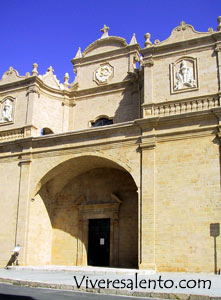 modern one through a bridge that was built in
1603, and that 150.000 dukedoms cost; in the past it was restored a lot of
times. The old citadel is fourteen meters above the sea level, completely
surrounded by the walls where there is an imposing castle that, probably, was
planned by Francesco Giorgio Martini from Siena. After some restorations it has
became a real fortress. At Gallipoli you can also admire some wonderful palaces. Tafuri Palace was built in the XVIII century in rococo style: now is
uninhabited, but in the past it belonged to the famous painter Giulio Pagliano.
Doxi Palace, also rococo, was planned by Adriano Preite in the XVIII century.
Also Palace del Seminario was planned by Preite, and it was made build in 1756
by the Bishop Branconi. Ravenna Palace, in Neoclassical style, was planned by
Gregorio Consiglio in 1828. D' Ospina Palace was restored in the XVIII century,
and here Antonietta de Pace and her sister Maria Rosa
were born. Episcopal Palace was made
restructure in 1653 by the Bishop Massa; inside you can see the painting
representing the Virgin with the Child by Gianserio Strafella. Many other
palaces are the historical centre, like: Zacheo Palace, Balsamo Palace (XVII
century), Arlotta Palace (XIX century), Pasca Palace , Muzio Palace, Talamo
Palace (XVII century), Venneri Palace (XVII century), Munittola Palace, modern one through a bridge that was built in
1603, and that 150.000 dukedoms cost; in the past it was restored a lot of
times. The old citadel is fourteen meters above the sea level, completely
surrounded by the walls where there is an imposing castle that, probably, was
planned by Francesco Giorgio Martini from Siena. After some restorations it has
became a real fortress. At Gallipoli you can also admire some wonderful palaces. Tafuri Palace was built in the XVIII century in rococo style: now is
uninhabited, but in the past it belonged to the famous painter Giulio Pagliano.
Doxi Palace, also rococo, was planned by Adriano Preite in the XVIII century.
Also Palace del Seminario was planned by Preite, and it was made build in 1756
by the Bishop Branconi. Ravenna Palace, in Neoclassical style, was planned by
Gregorio Consiglio in 1828. D' Ospina Palace was restored in the XVIII century,
and here Antonietta de Pace and her sister Maria Rosa
were born. Episcopal Palace was made
restructure in 1653 by the Bishop Massa; inside you can see the painting
representing the Virgin with the Child by Gianserio Strafella. Many other
palaces are the historical centre, like: Zacheo Palace, Balsamo Palace (XVII
century), Arlotta Palace (XIX century), Pasca Palace , Muzio Palace, Talamo
Palace (XVII century), Venneri Palace (XVII century), Munittola Palace,
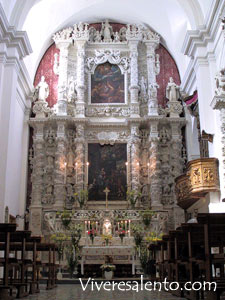 Romito
Palace , De Tomasi Palace, Cal˛ Palace , etc. Other typical
constructions of Gallipoli are the case a corte, houses where the rooms were
built on the first floor that could be reached thanks to a characteristic
staircase. The underlying space was the corte, where people used to meet and
spend much time. An other work of inestimable artistic value is the Ellenistica
Fountain, considered the oldest of all the fountains in Italy. It is made up of
the coat of arms of the Asburgos of Spain, the civic coat of arms of the country
and marvelous sculptures representing three legendary stories: that of Salmace,
Dirce and Biblide. We do not know when it was built: it was restored in 1560 and
in 1765. The people of Gallipoli are very proud of it, that is why they look at
it as the symbol of their town. The historical centre also boasts the presence
of a very interesting and suggestive oil press that, each year, attracts
numerous visitors.
The most important religious building is the Parish dedicated to St. Maria del
Canneto: it is with nave and two aisles and it was built in the XVII century;
inside you can see some wonderful altars, a very
particular ceiling representing the Madonna, a statue of St. Nicola and a
precious eighteen century painting representing St. Vito and St. Nicola. In the
historical centre there is the Cathedral in baroque style. It was made restore
in 1629 by a rich physician of that time, Giacomo Lazari. It has a fašade richly
decorated; it is with nave and two aisles, and what most strikes the visitor's
attention are the splendid paintings. The artists who made ,in baroque style,
the paintings are Nicola Malinconico from Naples, Andrea Coppola and Domenico
Catalano. Their most famous works are: The Martyrdom of St Agata, the Souls of
the Purgatory, the Trinity and the Madonna with the Child. The Church of St.
Domenico of the Rosary was restored in 1700 after the plan of Valerio Margoleo.
The nave has got an octagonal plant; the altar of St. Domenico of Guzman, is
made of golden wood, and it was realized by Giorgio
Aver. The Church of the Purity was built between 1659 and 1666, and it has a
very sober fašade with Romito
Palace , De Tomasi Palace, Cal˛ Palace , etc. Other typical
constructions of Gallipoli are the case a corte, houses where the rooms were
built on the first floor that could be reached thanks to a characteristic
staircase. The underlying space was the corte, where people used to meet and
spend much time. An other work of inestimable artistic value is the Ellenistica
Fountain, considered the oldest of all the fountains in Italy. It is made up of
the coat of arms of the Asburgos of Spain, the civic coat of arms of the country
and marvelous sculptures representing three legendary stories: that of Salmace,
Dirce and Biblide. We do not know when it was built: it was restored in 1560 and
in 1765. The people of Gallipoli are very proud of it, that is why they look at
it as the symbol of their town. The historical centre also boasts the presence
of a very interesting and suggestive oil press that, each year, attracts
numerous visitors.
The most important religious building is the Parish dedicated to St. Maria del
Canneto: it is with nave and two aisles and it was built in the XVII century;
inside you can see some wonderful altars, a very
particular ceiling representing the Madonna, a statue of St. Nicola and a
precious eighteen century painting representing St. Vito and St. Nicola. In the
historical centre there is the Cathedral in baroque style. It was made restore
in 1629 by a rich physician of that time, Giacomo Lazari. It has a fašade richly
decorated; it is with nave and two aisles, and what most strikes the visitor's
attention are the splendid paintings. The artists who made ,in baroque style,
the paintings are Nicola Malinconico from Naples, Andrea Coppola and Domenico
Catalano. Their most famous works are: The Martyrdom of St Agata, the Souls of
the Purgatory, the Trinity and the Madonna with the Child. The Church of St.
Domenico of the Rosary was restored in 1700 after the plan of Valerio Margoleo.
The nave has got an octagonal plant; the altar of St. Domenico of Guzman, is
made of golden wood, and it was realized by Giorgio
Aver. The Church of the Purity was built between 1659 and 1666, and it has a
very sober fašade with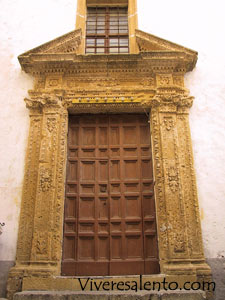 unusual tiles representing St. Francis, St. Joseph and the Virgin Mary. On the
contraty the interns are very decorated and full of splendid paintings. The
Church of St Chiara was built at the end of the XVI century as the Monastery,
that was destroyed in 1971. Inside the church you can admire the wonderful
altars decorated by the Catalano. The Church of the Carmine was rebuilt on a
pre-existing building in 1838, and it
was planned by Vito Donato from Galatone. Inside ithere is a painting made by
Giulio Pagliano representing the "Compianto" near the Cross. The Church of St
Maria of the Angels was made build by the fishermen:
the fašade is simple and there are four precious eighteen-century works made by
the painter Diego Bianchi. The Church of the Immaculate dates back to the XVIII
century and inside there are some interesting paintings (made by the painter of
Lecce, Tiso) representing Tobias' life. The Church of St Teresa of Altavilla,
together to the attached Monastery of the Carmelitane,
was finished in 1690, as the Spanish bishop Perez Della Lastra wanted. The
Church of the Crucifix was built in the XVIII century: it was planned by the
lieutenant Carlo Mult˛ and it is in baroque style. The Church of St. Francis of
Assisi was restored in 1736: it is known as the Church
of the Malladrone because of the statue, by Vespasiano Genuino.
unusual tiles representing St. Francis, St. Joseph and the Virgin Mary. On the
contraty the interns are very decorated and full of splendid paintings. The
Church of St Chiara was built at the end of the XVI century as the Monastery,
that was destroyed in 1971. Inside the church you can admire the wonderful
altars decorated by the Catalano. The Church of the Carmine was rebuilt on a
pre-existing building in 1838, and it
was planned by Vito Donato from Galatone. Inside ithere is a painting made by
Giulio Pagliano representing the "Compianto" near the Cross. The Church of St
Maria of the Angels was made build by the fishermen:
the fašade is simple and there are four precious eighteen-century works made by
the painter Diego Bianchi. The Church of the Immaculate dates back to the XVIII
century and inside there are some interesting paintings (made by the painter of
Lecce, Tiso) representing Tobias' life. The Church of St Teresa of Altavilla,
together to the attached Monastery of the Carmelitane,
was finished in 1690, as the Spanish bishop Perez Della Lastra wanted. The
Church of the Crucifix was built in the XVIII century: it was planned by the
lieutenant Carlo Mult˛ and it is in baroque style. The Church of St. Francis of
Assisi was restored in 1736: it is known as the Church
of the Malladrone because of the statue, by Vespasiano Genuino.
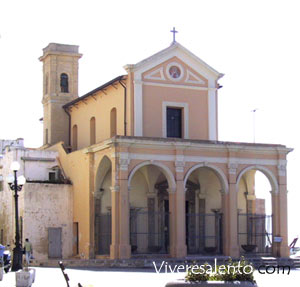 This
sculpture represents the crucifixion of Christ, but its particularity lies in
the sneer of pain and of disgust of the face of the statue. The imposing fašade
has a stately portal, surmounted by an enormous arc. The Church of St. Francis
of Paola was built in the XVII century: it has got a sober fašade, but the intern is richly
decorated and there are a lot of eighteen-century paintings by Vespasiano
Genuino and Oronzo Miccoli and a seventeenth-century wooden altar. Getting out
of the inhabited centre there are some ancient abbeys like that of
St. Salvatore of Gallipoli and of St. Mauro. We do not know
when the former was built, but according to some historical documents in 1347
the Archbishop of Otranto appointed a man, called Niceforo, abbot. The
rests of the paintings date back to the XIV century.
Currently, the whole building is in bad conditions. About the Abbey of St. Mauro
we do not have certain data, but according to some historical documents in 1149
the religious people living there received some donations, but at the end of
1400 nobody was in. The Abbey of St. Peter of the Samari was restored in This
sculpture represents the crucifixion of Christ, but its particularity lies in
the sneer of pain and of disgust of the face of the statue. The imposing fašade
has a stately portal, surmounted by an enormous arc. The Church of St. Francis
of Paola was built in the XVII century: it has got a sober fašade, but the intern is richly
decorated and there are a lot of eighteen-century paintings by Vespasiano
Genuino and Oronzo Miccoli and a seventeenth-century wooden altar. Getting out
of the inhabited centre there are some ancient abbeys like that of
St. Salvatore of Gallipoli and of St. Mauro. We do not know
when the former was built, but according to some historical documents in 1347
the Archbishop of Otranto appointed a man, called Niceforo, abbot. The
rests of the paintings date back to the XIV century.
Currently, the whole building is in bad conditions. About the Abbey of St. Mauro
we do not have certain data, but according to some historical documents in 1149
the religious people living there received some donations, but at the end of
1400 nobody was in. The Abbey of St. Peter of the Samari was restored in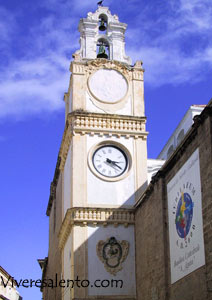 1148 by Ugo of Lusingano and, currently, it is in a state of abandonment. In the
surrounding country you can see some fortified farms,
thick constructions where in the past there where towers, drawbridges, etc.
Almost all of them were built in the same period, between the end of 1400 and
the beginnings of 1500. The most important ones are: St. Giorgio Farm, Itri
Farm, St. Leonardo Farm and St. Mauro Farm. Going from the historical centre
towards the sea there is the small Island of St Andrea; it covers a surface of
around fifty hectares, and it is two meters above the sea level. On the island
there is an old lighthouse( 1866 -1974). Gallipoli has three protectors: St.
Sebastian, that is celebrated each year on January 20th, St Agata that is
celebrated on February 5th, and St Cristina, that is celebrated on July 24th.
1148 by Ugo of Lusingano and, currently, it is in a state of abandonment. In the
surrounding country you can see some fortified farms,
thick constructions where in the past there where towers, drawbridges, etc.
Almost all of them were built in the same period, between the end of 1400 and
the beginnings of 1500. The most important ones are: St. Giorgio Farm, Itri
Farm, St. Leonardo Farm and St. Mauro Farm. Going from the historical centre
towards the sea there is the small Island of St Andrea; it covers a surface of
around fifty hectares, and it is two meters above the sea level. On the island
there is an old lighthouse( 1866 -1974). Gallipoli has three protectors: St.
Sebastian, that is celebrated each year on January 20th, St Agata that is
celebrated on February 5th, and St Cristina, that is celebrated on July 24th.

The nhabitants of Gallipoli are known as "ciucci" that means donkeys. This is
not a negative nickname, but it
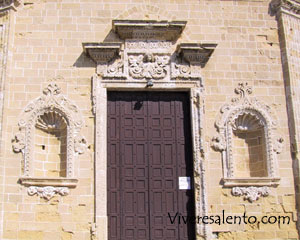 makes
reference to the amount of work done by the people of Gallipoli due to the
presence of the harbour. In fact, after that of Naples, the harbour of Gallipoli
was considered the most important of the South of Italy. Thanks to it the trade
of the agricultural goods, above all of the oil, increased all over in Europe.
An other eccentric nickname is "¨ttari," coming from "barrel". In fact, when the
people of Gallipoli started to deal in oil, they noticed that in the cold
regions it got solid. So they made some cheap barrels that were used only for
the transport. makes
reference to the amount of work done by the people of Gallipoli due to the
presence of the harbour. In fact, after that of Naples, the harbour of Gallipoli
was considered the most important of the South of Italy. Thanks to it the trade
of the agricultural goods, above all of the oil, increased all over in Europe.
An other eccentric nickname is "¨ttari," coming from "barrel". In fact, when the
people of Gallipoli started to deal in oil, they noticed that in the cold
regions it got solid. So they made some cheap barrels that were used only for
the transport.
|